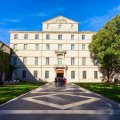Museum housing a collection of several thousand works of art, including Flemish and Dutch paintings
The Fabre Museum is the city's main art museum and has been awarded the "Musée de France" label (an appellation designed to group together French museums in the perspective of a large public museum service). It is indeed the muse of the Esplanade of Montpellier. Wedged between two ultra-touristy points, the Corum on the one hand and the Comédie on the other, the museum has indeed something to strut about since it was installed in the Massilian mansion, a former private mansion and imposing 18th century fort. Full of history even before the collections were installed there, the museum also absorbs within its walls the former Jesuit College, a magnificent building from the end of the 17th century which today serves as the entrance hall for visitors.
The museum was originally created following a proposal made in 1824 by François-Xavier Fabre (1766-1837), a painter and collector, to donate his collections to the city of Montpellier on condition that a museum be built to house them. Fabre, winner of the grand prize for painting at the Académie in 1787, had lived in Rome from 1788 to 1793, then permanently in Florence. He had gradually built up a very rich collection of paintings and drawings.
After three years of work financed by the municipality, the museum finally opened its doors on December 3, 1828. Today, the museum is still constantly enriched by numerous donations, bequests and purchases, and is expanding physically as new acquisitions are made in the adjacent buildings, eager to offer visitors more and more novelties to put under their teeth!
In constant evolution, the museum has earned its credentials locally and nationally. Renovated between 2003 and 2007, it represents one of the most important collections in France. Indeed, in 2021, in seven exhibition rooms, the permanent collection will include more than 2,000 paintings, 300 sculptures, 4,000 drawings and 1,500 engravings. It is completed by a collection of several thousand art objects. Within these rooms, the public discovers a so-called ancient route with Flemish and Dutch paintings, paintings and sculptures from the 14th to the mid-18th century as well as a large section dedicated to the neoclassical style.
The famous painter Pierre Soulages donated part of his collection to the museum, which is presented in a specially dedicated pavilion.
The modern exhibition presents contemporary sculptors of Languedoc origin, such as Germaine Richier (La Montagne), who died in Montpellier in 1959, Aristide Maillol and René Iché, as well as artists of the support/surfaces movement, many of whom are natives of the region (Claude Viallat, Vincent Bioulès or Daniel Dezeuze).
Every two months, the Fabre Museum also hosts temporary exhibitions on various themes. Last September-October, we saw "United states of abstraction: American artists in France from 1954 to 1964" or in November-December, "Beauty in sharing: a retrospection on the last 15 years of acquisitions of the museum". Thus, the museum always offers a new facet!
The Hôtel de Cabrières-Sabatier d'Espeyran, housed in a 19th century mansion, is home to the Fabre Museum's Decorative Arts Department. This historical residence offers the opportunity to discover the living environment of the bourgeois and aristocratic societies of the 18th and 19th centuries. Having preserved all the elements that made up these apartments, the Cabrières-Sabatier d'Espeyran hotel offers a unique ensemble. In the faithfully reconstructed settings of its salons, this private mansion reveals its remarkable collection of furniture, as well as exceptional ceramics and silverware.
As you can see, the Fabre Museum is not only one, but several jewels of local and European cultural history. Resolutely turned towards the outside world, the museum, very dynamic, is a reference in terms of cultural mediation and social inclusion. Indeed, the teams of the public service do their utmost to welcome visitors of all ages and without distinction, individuals or schoolchildren, during animation sessions or initiation and sensitization to art and in particular to painting. The museum thus offers activities adapted to young children (from the age of 2) thanks to "pathway kits", "tailor-made" activities for disabled visitors thanks to new forms of mediation, in particular multi-sensory resources (models, interpretation kits, olfactory and sound devices, etc.), digital tours of the museum from your couch, as well as other quality activities on the occasion of Museum Night, for example. The museum also has a 124-seat auditorium that hosts programming related to national and international artistic news, a store attached to the Sauramps bookstore offering a selection of merchandise based exclusively on the museum's collections, and a restaurant. A true emblem of the Esplanade and of culture in Montpellier, the stones of the Fabre Museum literally come to life once a year on the occasion of the "Cœur de Ville en lumières" event, when it becomes the special receptacle of a light and music show; a different way of (re) discovering it and affirming its importance in Montpellier life.
Did you know? This review was written by our professional authors.
The strengths of this establishment:
Book the Best Activities with Get Your Guide
Members' reviews on FABRE MUSEUM
The ratings and reviews below reflect the subjective opinions of members and not the opinion of The Little Witty.
Find unique Stay Offers with our Partners







Une collection permanente exceptionnelle avec des peintures et des sculptures de quelques très grands noms.